|
 | Add on planes - Gliders |  |
All
Virtual Sailor and Micro Flight add-ons install and run on Vehicle Simulator
| DFS SG 38 Schulgleiter | Author: Pascal Dumat &
Thomas Brueckelt |
|
From Wikipedia
The SG 38 was designed to be a training glider for basic
flight training by the Nationalsozialistisches Fliegerkorps
(NSFK). The usual launch method was by bungee cord from a
sloped hill. Because training was conducted solely by solo
flight the aircraft had to be very easy to fly and also easy
to repair.
The high-wing design uses a kingpost and
cable bracing. The primary structure of the glider is of wood,
with the wings, tail surfaces and inverted "V" kingpost all
finished in doped aircraft fabric covering. The pilot sits on
a simple seat in the open air, without a windshield.
The basic
configuration was similar to earlier gliders such as the
Stamer Lippisch Zögling and the Grunau IX, but the SG 38 was
an entirely new design. Improvements included enlarged tail
surfaces for better stability, a separate skid mounted on
shock-absorbing springs, and an updated seat for the pilot.
The SG-38 played a critical role in pilot training for the
Luftwaffe in the Second World War, as a simple, but robust,
trainer for the rapid increase in the number of pilots needed
by Germany. It was commonly flown by bungee launch on the
slopes of the Wasserkuppe.
From 1949 to 1951 Spain's
AISA produced 50 licence-built aircraft.[4]
In the UK,
Elliotts of Newbury built a copy of the SG.38 called the
Elliotts Primary EoN; its version first flown in 1948 and used
by the RAF as the Eton TX.1.
This
great glider has been made by Pascal Dumat &
Thomas Brueckelt
|
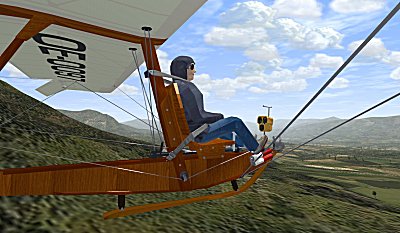
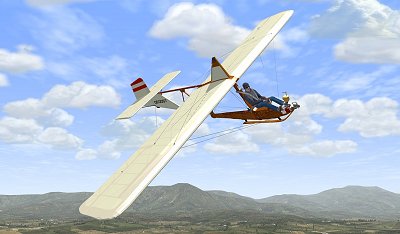
|
|
Download (
0.9 MB ) |
|
|
| The SZD-59 Acro Glider
| Author: Pascal Dumat &
Thomas Brueckelt |
|
Allstar SZD-59 Acro for Vehicle Simulator (c) Ilan Papini
This is the model of the polish SZD-59 Acro in the
aerobatic configuration (short wingspan: 13,20m).
The
SP-3886 belongs to the Allstar company and is the demonstrator
of the reworked SZD-59-1 from 2017.
The model has
smoke, press CTRL+S to use it.
You can open tha canopy by
pressing CTRL+D.
Like the original, the VSF-model has full
aerobatic capability: You can do flicks, spins, tailslides...
Care for the g-limits and the speed, the SZD-59
accelerates quick on downward lines.
Good speed for
flick rolls is ~155 km/h.
The 3D model was made by
Thomas Brückelt.
Pascal Dumat transferred it into the
Vehicle Simulator, added animations, the pilot
and
instruments.
Thomas Brückelt made the flight model and
painted the textures.
Here you find two videos made by
Thomas Brückelt of the real one, together with nice wooden
decoration
models from Pureplanes:
https://youtu.be/fvV9cUOAO3Q
and with music from the
band Rock Unlimited, playing "Jump!" from Van Halen:
https://youtu.be/zz272GTnVts
Here you find a
description & a video for glider aerobatics in VSF (PDF on the
bottom of the site):
https://www.flightsim.com/vbfs/content.php?17856-VSF-Glider-Aerobatics
This
great glider has been made by Pascal Dumat &
Thomas Brueckelt
|
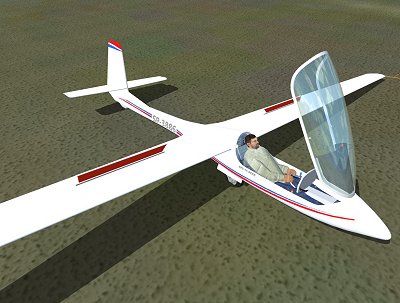

|
|
Download (
2.75 MB ) |
|
|
| The Messerschmitt S9 Glider
| Author: Pascal Dumat &
Thomas Brueckelt |
|
The Messerschmitt S9 was an unsuccessful experimental
glider from 1921 Because of lack of aerodanamic stability it
crashed on the first flight.
Of cause in VSF center of
gravity is in the right position and you can fly it.
Bungee launch is simulated: Place the S9 on a hill. Use
the Map; press "M" and move the crosshairs to the place you
want to start your flight and press "Go to".
Give full
throttle and after that press "E" to start your flight.
You can also use the two prepared Situations
"Messerschmitt S9" and Messerschmitt S9 Thermals", coming with
this model.
The project was inspired by Matthias Simon
from www.airmodel.de.
There exists only one fotography, no
technical datas or drawings. So the 3D model was redesigned
just by using the picture by Thomas Bruckelt.
Pascal Dumat
transferred it into the Vehicle Simulator, added animations,
the Pilot and instruments.
Thomas Bruckelt made the flight
model and painted the textures.
Jump back in time to
the beginning of aviation and enjoy!
This
great glider has been made by Pascal Dumat &
Thomas Brueckelt
|
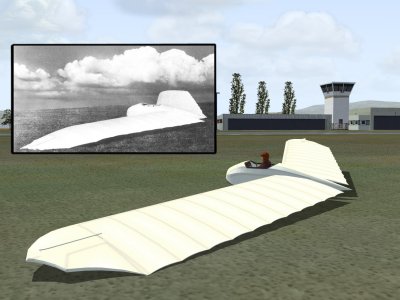
|
|
Download (
1.7 MB ) |
|
|
| The ASK-21 Glider
| Author: Pascal Dumat &
Thomas Brueckelt |
|
The model of the Schleicher ASK-21 shows the D-3868, used
by the "Forderverein fur Segelkunstflug im BWLV", a club for
aerobatic gliding in south / west Germany. The ASK-21
is good for basic aerobatic, it's easy to control and
uncritical.
Because of its gentle flight charcteristics and
its structural strength the ASK-21 is used in many clubs as
training aircraft. The maiden flight of the ASK-21 was
in 1978.
Enjoy this famous, little areobatic glider!
This
great glider has been made by Pascal Dumat &
Thomas Brueckelt
|
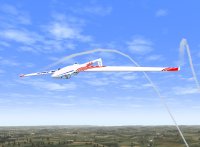
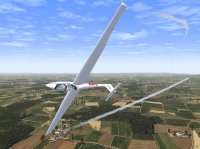
|
|
Download (
1.7 MB ) |
|
|
| DFS Habicht E, F for Vehicle Simulator |
Author: Pascal Dumat &
Thomas Brueckelt |
|
After Thomas Bruckelt flew the replica of the DFS Habicht
(hawk)
https://www.youtube.com/watch?v=OWUr0pq_u4w Pascal
Dumat prepared Wolfgang Pipers original (
http://www.fsglider.de/p_e.htm ) model for Ilan Papinis
Vehicle Simulator.
Some details, pilot and animations
were added to give a realistic impression of this beautyful
historic aerobatic glider (originally designed in 1936 by Hans
Jacobs).
Thomas Bruckelt made the flight model according to
his experiance with the real glider.
The D-6868 was
built by some members of the German aeroclub FSV Vaihingen
https://www.fsv-vaihingen.de/technik/habicht/.
They
started building the glider in 2004.
For
aerobatics it´s recommended to set the trim to -4.0.
A good
speed for flick rolls is 140...150 km/h. The airbrakes are
relatively ineffective, for landing you need to sideslip
(move aileron and rudder in opposite direction to get a
higher sinkrate).
The model is equipped with smoke:
Press CTRL+S to activate it. This great add-on pack has been made by Pascal Dumat &
Thomas Brueckelt
|
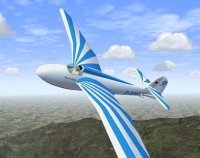

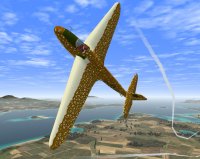
|
|
|
|
|
DFS Habicht E D-6868
Download (
1.5 MB ) |
|
|
DFS Habicht E D-8002
Download (
1.5 MB ) |
|
|
DFS Habicht F
Download (
1.5 MB ) |
|
|
| The Lo-100 Glider/td>
| Author: Pascal Dumat &
Thomas Brueckelt |
|
The D-8849 "Gilb" belongs to the "Forderverein fur
Segelkunstflug im BWLV", a club for aerobatic gliding in
south/west Germany:
www.segelkunstflug.com
The Lo-100 has no
speedbreaks, so you have to make a side slip to rise the
sinkrate for landing.
Therefore keep the nose above the
horivon, move aileron a bit to one side, and right after that
the rudder to the opposite.
See the screenshot
"Lo-100_sideslip.jpg" in the Lo-100_Gilb-folder.
Maximum
speed for flick rolls: 130 km/h
The model has smoke on
the wingtips, you can switch it on/off by pressing CTRL+S.
To open/close the little window of the canopy press CTRL+C.
Enjoy this famous, little areobatic glider!
This great add-on pack has been made by Pascal Dumat &
Thomas Brueckelt
|
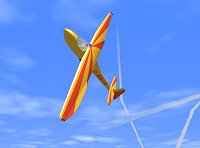
|
|
Download (
2.5 MB ) |
|
|
| Cirrus K |
Author:
Marcel
Aerni & Thomas Brückelt |
| From Wikipedia, the free encyclopedia
The Standard Cirrus was designed by Dipl. Ing. Klaus Holighaus and flew for the first time in March 1969. It is a Standard Class glider with a 15 metre span and no camber-changing flaps. The all-moving tailplane, a feature of many designs of that period due to its theoretically higher efficiency, caused less than desirable high-speed stability characteristics, and so modifications were made to the early design. Even so, the glider is still very sensitive in pitch.
Improvements were made with the Standard Cirrus 75. These included better air-brakes with an increased frontal area. By April 1977, when production by Schempp-Hirth ended, a total of 700 Standard Cirruses had been built, including 200 built under licence by Grob between 1972 and July 1975. A French firm, Lanaverre Industrie, had also built 38 Standard Cirruses under licence by 1979. VTC of Yugoslavia also licence-built Standard Cirruses, reaching approximately 100 by 1985.
The Cirrus K was made out of the Standard Cirrus in the end of the 1980s. Wilhelm Duerkop (better known as "Salzmann") started to realize his idea of an easy to handle aerobatic glider, basing on a standard glider, so that development saves costs and makes it interesting for gliding clubs.
The wingspan was shorted to 12,60 m, the fuselage is enstrengthed and the tailplane was completely changed. It has full aerobatic capability, the g-limits are +7 / -5, Vne is 290 km/h.
Two Cirrus K were built. The D-4747 was the first one and is used by members of the "Foerderverein Segelkunstflug" (aerobatic flying club of south/west Germany). The other one is the D-3092 which is in private use and has little improvments.
This great glider has been made by Marcel
Aerni
The flight model was made and tested by Thomas Brückelt
|
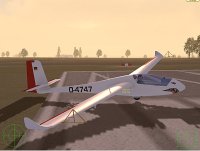

See
this glider in action
See glider
action in VSF
|
| Download (
6.0 MB ) |
|
|
| Schneider Grunau Baby |
Author:
Marcel
Aerni |
| From Wikipedia, the free encyclopedia
The Schneider Grunau Baby (named for the town where Schneider's factory was located - now Jezów Sudecki in Poland) was a single-seat sailplane first built in Germany in 1931, and with some 6,000 examples constructed in some 20 countries, is the most widely-built sailplane to date.
It was relatively easy to build from plans, it flew well, and the aircraft was strong enough to handle mild aerobatics and the occasional hard landing.
When the Baby first appeared, it was accepted wisdom that the pilot should feel as much unimpeded airflow as possible, the better to sense rising and falling currents of air, temperature changes and the like.
This fantastic glider has been made in two versions by Marcel
Aerni
|
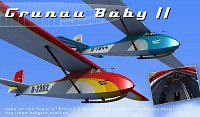 |
| Download (
8.0 MB ) |
|
|
| ASK 21 |
Author: Ian
Hay |
The ASK 21 is a modern glass-reinforced plastic two-seater glider with a mid-set wing and a mass balanced T-tail. The ASK 21 is designed primarily for beginner instruction, but is also suitable for cross-country flying and aerobatic instruction.
This fantastic plane has been made by Ian
Hay |

|
|
Download (
0.4 MB ) |
|
|
| Goe-3 Minimoa |
Author: Brian
Ford |
First developed in the 1930s in Germany. One of
the worlds first true high performance soaring aircraft.
Design is based on a later modified type.
This beautiful glider was built by Brian
Ford |
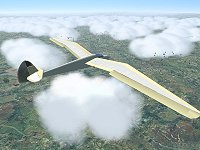
|
| Download (
0.4 MB ) |
|
|
| Maxair Drifter |
Author: Ilan Papini |
The Maxair Drifter is a tandem seating two place
in a taildragger, using standard stick and rudder
control.
Power is supplied by Rotax 503/582/618 engine
located above and behind the wings.
|
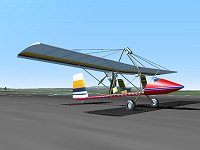 |
| Download ( 0.5
MB ) |
|
|
| The Slingsby T21b |
Author:
Kevin Smith |
This model of the Slingsby
T21b is dedicated to Derek Moore and the York
Gliding Centre ( where the original craft is
based).
I hope they will overlook the shortcomings of the
model. It is meant to capture some of the spirit
of the real thing.
Credit certainly goes to Derek who provided the
photos and information which made the model
possible.
This model of the Slingsby T21b was built by Kevin Smith
, June 2004, Sylvan Lake Alberta. |
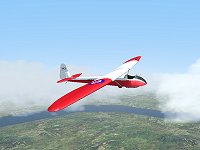
|
| Download ( 1.2
MB ) |
|
|
| Schleicher KA-8 Glider |
Author:
Victor Egorov |
One of the most popular
training gliders, the KA-8 is known in almost any
gliding club in the world for being a reliable
and easy to fly glider, with a demium gliding
performace and slow flying speed..
This excellent glider has been made by Victor Egorov |
 |
| Download ( 0.2
MB ) |
|
|
| The Standard Cirrus |
Author:
Kevin Smith |
The Standard Cirrus is a
standard class glider (15 meter span without
flaps) with airbrakes on the upper wing surface
only.
It has an all-flying elevator and a steel-tube
frame in the fuselage to which the wings and the
main-wheel retraction mechanism are attached.
The wings are of a PVC foam core construction
with a fiberglass skin.
This beautiful glider was created by Kevin Smith |
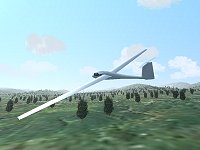
|
| Download ( 0.35
MB ) |
|
|
| Storch 4 by A.Lippisch |
Author:
Marcel
Aerni |
Flying-Wing Design of the
famous Alexander Lippisch.
He began in the mid-1920 to experiment with
tailless designs.
He build and flew many large scale models before
proceeding to full-sized, man-carrying types.
He did also a lot of wind-tunnel test to
establish most of the vital requierments for
stability and control of such aircraft.
The storch-series was the beginning of many
succsessfull developments of witch the most
famous is the rocket-driven interceptor Me 163.
Storch 4:
wingspan 12.2m
wing area 18.667 sq m
Aspect ratio 7.97
This fantastic glider has been made by Marcel
Aerni |
 |
| Download ( 0.4
MB ) |
|
|
| HK36 Super Dimona |
Author:
Victor Egorov |
Since 1990: beloved and flown
around the world:
The series of HK36 Super Dimona (known in the USA
and Canada as Kantana X-treme series), the
efficient two-seated powered glider made of
fiber-reinforced high-tech composite.
Equipped with Rotax engines with 80, 100 and 115
hp (turbo-charged variant), the Super Dimona is
perfect for glider pilot training and glider
towing.
Manufactured by Diamond
industries
This fantastic plane has been made by Victor Egorov |
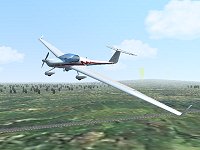 |
| Download ( 0.4
MB ) |
|
|
| Aerolight 103 Ultralight |
Author:
Ilan
papini |
The Aerolight 103 is a popular
and fun to fly single seat ultralight,
manufatured by Aeroworks ltd.
This ultralight comes both as a kit and in ready
to fly mode, and is the favorite choice by those
who wish to enjoy a powerful ultralight with good
flying quality at an affordable price. |
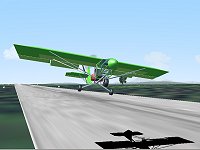 |
| Download ( 0.35
MB ) |
|
|
| Windex 1200 |
Author:
Keith L. Quinney |
The Windex 1200 is a small aerobatic motor
glider, kit built from composite mouldings,
offering excellent performance from a small and
economic package.
Press button "c" only whilst on the
ground!
See addtional repaints in plane directory.
Beautifully modelled by
Keith
L. Quinney |
 |
|
Download ( 0.4 MB ) |
|
|
| Paragliders |
Author:
Ilan Papini |
|
In this add-on you will find three paragliders, the
Eagle the Kantega and the Paraplane. |
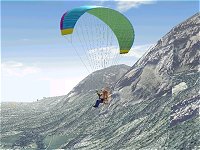
|
|
Download (
1.0 MB ) |
|
|
| Paraplane |
Author:
Ilan Papini |
|
The
Paraplane is a high powered slow flying
paraplane.
|
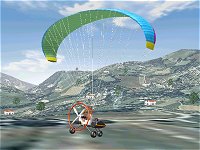
|
|
Download (
0.5 MB ) |
|
|
| Sensor |
Author:
Ilan Papini |
| The Sensor is a high performance unpowered
Hang Glider. |
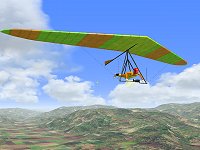 |
| Download ( 0.5
MB ) |
|
|
|
|
